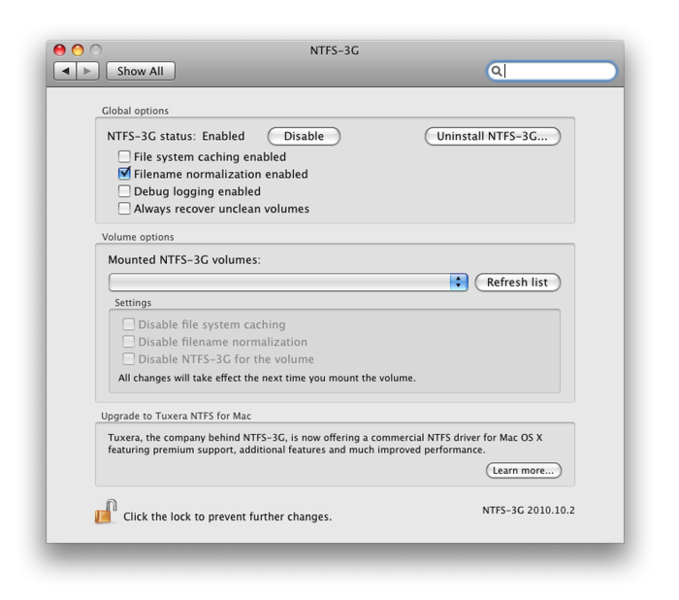

Pravin:/home/pravin # rpm -qa | grep -i ntfs line at the END() of the /etc/fstab file: /dev/sda1 /mnt/windows ntfs-3g. Pravin:/home/pravin # cat /etc/SuSE-releaseįilesystem Size Used Avail Use% Mounted on
NTFS 3G ETC FSTAB INSTALL
Save this, and now every time you boot your machine your ntfs drive will b mounted and ready to use!Ĭan you give me the solution to install it because I can’t mount ntfs partition’s. dev/hda1 /media/windows ntfs-3g defaults 0 0 Modify the file in your text editor of choice and add the line Be very careful!!!! If you damage this file it will not boot. To do this we have to modify a file called fstab. So here is another little trick to auto mount it whenever the system starts. You don’t want to have to manually mount the drive every time you boot up Debian. So hopefully those few words are going to save you much more time than I spent trying to get the thing to work properly. U-mount, not un-mount! I saw unmount whenever I read this for ages and couldn’t for the life of me figure out what was going on. Now here is a very important step that had me stumped for ages. You can now double click and access the files inside. This should be labeled as whatever you called your folder in /media. If yours works like mine did then you should also get a drive icon on the desktop. If you navigate to it now you should see your ntfs files inside. This last command mounts hda1 with ntfs-3g in the /media/windows directory. Mount –t ntfs-3g /dev/hda1 /media/windows I called my directory ‘windows’ but you can call it what you want. You have to tell it where you want it to put the information. Linux won’t create somewhere dynamically for you. Solution: Add the ‘exec’ mount option to the end of the mount options. The next step is to create a folder to mount the drive in. when using the ‘user’ or ‘users’ mount options in the /etc/fstab file, are done with the ‘noexec’ mount option by default for security reasons.

There should be nothing coming up unless this isn’t the first time you are attempting this. Check it isn’t mounted already by typing Re: Solved NTFS-3G ignoring mount options in /etc/fstab ftr, this was less meant as actual criticism at proton and more to stress that the inference is maybe a bit flawed. So now we know your ntfs drive is located on hda1. You’re not going to be able to mount anything if Linux can’t see it. This applies even when using fstab with the users option. The first step is to ensure your Debian system ‘sees’ the ntfs drive. NTFS-3G can let users other than root mount NTFS filesystems, but you'll have to set the suid flag in /bin/ntfs-3g. Once you have the two packages installed we can begin. Ntfs-3g is a third party package that allows reading and writing to ntfs drives, which is the holy grail for me right now! You will need these two packages installed before you begin the process. The process has two dependencies, ntfs-3g and libfuse 2. The tools won’t make Linux use ntfs, they just allow you to access them. Once I had trawled the forums and help pages and found out I can still use ntfs to a degree I was sold.
NTFS 3G ETC FSTAB WINDOWS
Ready, now we must find out exactly what partition we want to mount, that is, its real location.As an ex Windows user, I still have quite a collection of music on my old NTFS drive that I don’t want to mess with Fortunately you can mount the drive in Linux and read and write to it as you would have done before Here I get the best of both worlds.īeing able to access my old Windows drives was one of the big barriers to my coming over to Linux. We must first create a folder in /half/, for example: / media / windows To do this, open a terminal and put the following in it:Ģ. Suppose we have a partition called "Windows" (without the quotation marks), and we want that whenever we start the computer, this partition is accessible, that is, that it is mounted. let's focus on what we are dealing with now 😉 The / etc / fstab file is useful for many things, but. There are several ways, but in this post I will show you the most common, using / etc / fstab
NTFS 3G ETC FSTAB HOW TO
How to do so that we can automatically access this partition from Linux? In other words, suppose we have a part of the hard disk (100GB for example) in a different partition, a partition that we use to store our things, or play games on Windows. One of the things that many users want to do is automatically mount a partition automatically.


 0 kommentar(er)
0 kommentar(er)
